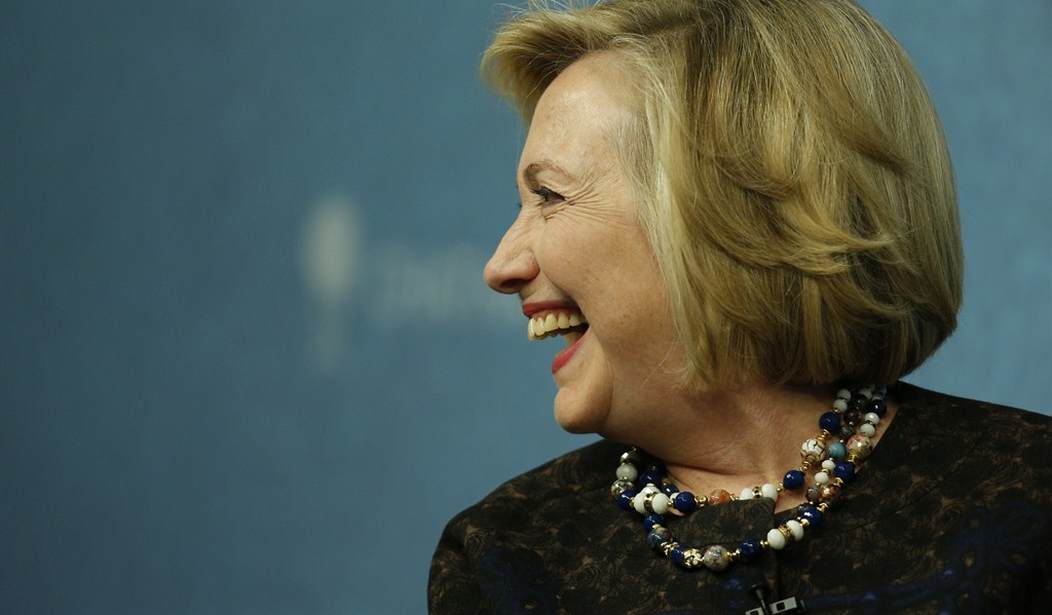Forty-five years ago Hillary Rodham made a fateful decision. It has defined her life.
Understanding that moment of decision is essential to understanding Hillary Clinton’s life — the successes and the failures and, perhaps, the future. It would explain the subtly discordant persona that causes the media — even many elite Hillary sympathizers — to present her as some kind of fabulous monster. And it may reveal something of the soul within.
Hillary Rodham chose the path of “central power” rather than the path of “personal dignity.” There is some evidence she is not fully at peace with that decision. Much depends, for her, her party, and America, on what she does next.
A media Hurricane Hillary begins to blow. It’s a Cat 5. The New York Times recently reports that the (by far) largest Democratic SuperPAC, which in 2008 had opposed Hillary Clinton, now actively is supporting her presumptive candidacy. Yet the elite media attention has an odd aspect.
Time Magazine’s January 27th cover story Can Anyone Stop Hillary? is illustrated by a tiny man dangling from the bottom of a raised stiletto heel. It is an odd, slightly monstrous, image. The New York Times Magazine, on January 26th, presents a Hillary Clinton cover generating enormous, unanticipated, buzz. Entitled Planet Hillary, it presents her with a distinctly alien mien. Again, a faintly monstrous depiction… in a sympathetic venue. Typical media cheek? Or something more?
Hillary Clinton is, without question, formidable. She is smart, skilled, experienced in seeking and wielding power. Formidable, however, is freighted praise. It conveys admiration but not likability. Frankenstein’s monster was formidable.
Hillary Clinton is more than just formidable. Despite (indeed because of) having spent all of her adult life in the public eye, she also is guarded. She presents as enigmatically somewhat tormented. There is an unguarded keyhole to help us read the inner Hillary Rodham Clinton. It offers a possible clue to this strange phenomenon. Planet Hillary concludes “there’s still something at the center [of Hillary Clinton] that’s aching for the rest to be peeled away.”
Recommended
Could the key reside here: Hillary Rodham’s 1969 Wellesley Bachelor’s honor’s thesis, “THERE IS ONLY THE FIGHT…” An Analysis of the Alinsky Model? There we encounter the voice of a precocious, erudite and witty prodigy. The thesis’s epigram is from T.S. Eliot’s East Coker, rather poignantly explicating the title chosen: “There is only the fight to recover what has been lost And found and lost again and again.” There is, even then, a sense of brave futility.
Her honor’s thesis strongly suggests that just before stepping onto the public stage Miss Rodham reached a fork in her life’s road. She received, and declined, a job offer from the premier anti-establishment populist of our epoch, Saul Alinsky. She chose, instead, to take the road more traveled and go to the liberal-establishment Yale Law School. This choice turned out, for her, to be defining. It also is telling. Perhaps fateful.
Alinsky, as Hillary Rodham understood, was a passionate populist. Populism, as defined by public intellectual Jeffrey Bell (with whom this columnist has a professional association), is optimism about people’s ability to manage their own affairs relative to the ability of an elite to do so for them. Alinsky had this optimism in abundance. It was his defining characteristic. What Alinsky stood for, far more than his famous thirteen tactical rules, was the principle of human dignity: the capability of and existential need for people to participate in forging their own destiny.
Hillary Rodham consciously turned away from the participation by rank-and-file citizens from solving their own problems by finding and exercising their own power. She diffidently turned, instead, both explicitly and by deed, toward central planning. That choice brought her power, wealth, glory, and celebrity.
Yet there is good evidence that she chose this course not primarily for careerist reasons. She chose it as the better path to improve the human condition. Hillary Clinton, by credible reports, is a natural caregiver. Yet after 45 years in public life, including positions of great prestige and power — First Lady of Arkansas and of the United States, United States Senator, Secretary of State — there is little evidence that she materially has advanced her existential objective, social transformation.
Few true populists, either of the left (such as Alinsky) or of the right, believe that central planning can much improve the human condition. And it undermines personal dignity. Forty-five years of participation in the futility of central planning (however authentic was, and possibly is, her belief in its efficacy) would bring inner conflict to one whose central motivation is devotion to the betterment of society.
Hillary Rodham’s purpose of social improvement consistently has been thwarted. Not by a vast right wing conspiracy. Thwarted by an internal contradiction. Central planning does not work.
To understand the significance of Miss Rodham’s thesis and what it says about her, first, though, it is necessary get clear on Alinsky. Alinsky’s name tends to be an incendiary conversation stopper. Alinsky was a proxy target for Barack Obama (who never met him). If Clinton runs for president, Alinsky is destined to become a proxy target for her, and an epithet.
To continue to misunderstand Alinsky is a terrible waste of an opportunity to understand the political transformation on the cusp of which America hovers. It may even be fair to say that a correct understanding of Alinsky may be essential to a full understanding of contemporary politics and of the upcoming 2016 election. A proper understanding of Alinsky also appears key to understanding Hillary Rodham Clinton. Hillary Rodham declined his job offer. This matters.
Most conservatives relentless vilify Alinsky as a communist. This is wrong.
Alinsky, in his writings and deeds, was an explicit anti-communist. Alinsky, Rules, p. 10:
We have permitted a suicidal situation to unfold wherein revolution and communism have become one. These pages are committed to splitting this political atom, separating this exclusive identification of communism with revolution. If it were possible for the Have-Nots of the world to recognize and accept the idea that revolution did not inevitably mean hate and war, cold or hot, from the United States, that alone would be a great revolution in world politics and the future of man.
Anti-communism was not a popular position for a man of the left to take in his era. Moreover, Alinsky personally advised Cardinal Montini, who would go on to become Pope Paul VI, on how to counter the Italian Communist Party. Alinsky also was an intimate of the great Catholic philosopher Jacques Maritain who praised, in a letter to Alinsky, Rules for Radicals. (For the record, let us note, Alinsky of course also abjured Joe McCarthy’s demagoguery masquerading as anti-communism.)
Neither was Alinsky a conventional Big Government liberal. He loudly called LBJ’s War on Poverty “political pornography.” When Sargent Shriver crowed that LBJ had “helped more Negros in 25 months than Alinsky had helped in 25 years,” Alinsky shot back that “Shriver has a ‘zoo-keeper mentality, desiring not to help Negroes in ghettos, but to keep them quiet.’”
Alinsky observed: “We (the Industrial Areas Foundation) spend $100,000 a year, and Shriver compares us with the U.S. Government. Shriver says he’s done more for the Negro than we have. He’s telling the truth. We’ve never done anything for the Negroes; we’ve worked with them.” This was not lost on Hillary Rodham. She quoted it in her thesis.
The right conflates Alinsky’s provocations with elements of the New Left to which Alinsky did not belong. These are the same elements of the left condemned, in her thesis, by Hillary Rodham as showing “elitist arrogance and repressive intolerance.” The right also wrongly vilifies Alinsky because Alinsky engineered his own notoriety. “Today, my notoriety and the hysterical instant reaction of the establishment not only validate my credentials of competency but also ensure automatic popular invitation.”
Alinsky did not, as is often claimed, dedicate Rules for Radicals to Lucifer. He offered a provocative epigram, one of three, no more sinister than Churchill’s trope that “If Hitler invaded hell I would make at least a favourable reference to the devil in the House of Commons.” (Ruleswas dedicated to Alinsky’s wife, Irene. Not Lucifer.)
Alinsky was neither saint nor devil. He exemplified Rabbi Hillel’s dictum, one dear to his heart: Where there are no men, be thou a man. His nature best can be appreciated by reading, in full, Rules for Radicals and by reading Sanford Horwitt’s definitive biography, Let Them Call Me Rebel.The real importance of Alinsky — to American politics and for understanding Hillary Rodham Clinton — lies not in his rules but in his credo. Alinsky:
We learn, when we respect the dignity of the people, that they cannot be denied the elementary right to participate fully in the solutions to their own problems. Self-respect arises only out of people who play an active role in solving their own crises and who are not helpless, passive, puppet-like recipients of private or public services. To give people help, while denying them a significant part in the action, contributes nothing to the development of the individual. In the deepest sense it is not giving but taking — taking their dignity. Denial of the opportunity to participate is the denial of human dignity and democracy. It will not work. (Rules for Radicals, pp. 122-3)
Hillary Rodham explicitly acknowledged Alinsky’s argument. Yet she chose the path of establishment liberal — the path of central planning — instead.
Why?
And what might that say about her?
To be continued.

























Join the conversation as a VIP Member